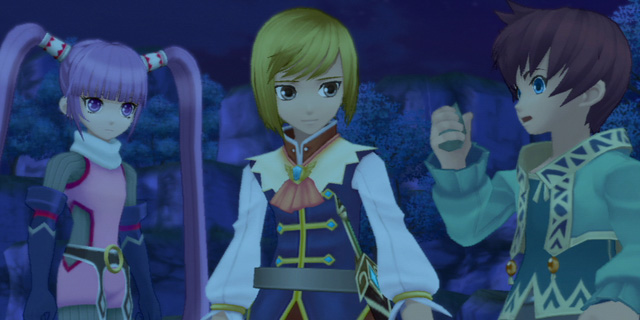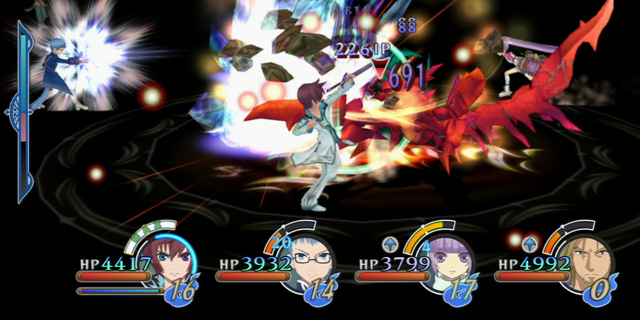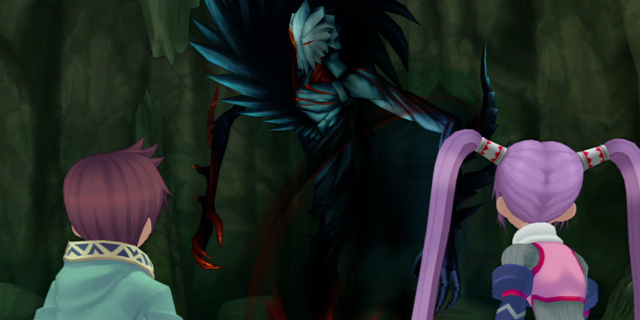
The Tales series is a tough one to gauge in the US, marked as it is by inconsistent localizations and wildly varying quality. Despite the fact that 8 of the 14 main series games have eventually been localized, it’s probably a good bet that people haven’t played any of them. Regardless of your past Tales experience though, Tales of Graces f deserves a spot in your collection.
Graces f is a story about friendship, a theme that arises quickly in the prologue. The game starts out with Asbel Lhant, the main character, and his brother Hubert heading up a hill near their town, hoping to see whether it’s true that flowers bloom all year round at the top. When they arrive, they find an unusual girl with no memory of her past. Taking her under his wing, Asbel decides to name her Sophie, after the flowers growing where they found her. Upon returning home, we’re introduced to Cheria, a frail lifelong friend, and soon after meet up with the young prince of Windor, Richard. Despite numerous warnings and commands from his father, the Lord of Lhant, Asbel takes it upon himself to unite the quintet with the bonds of friendship. Throughout the rest of the prologue, we see their friendship grow, until a terrible loss upends their lives and shapes the events of the next several years leading to the beginning of the story proper.
The prologue is actually quite lengthy and is something I’d love to see more games attempt. Knowing a character’s back story and actually witnessing or playing it are two entirely different things. Getting a chance to play through the formative events of the characters’ pasts serves to make them more interesting and gives you a greater sense of attachment to them.

The combat in Graces f is a bit of a departure from the standard Tales formula. Battles are still real-time 2.5D battles between your AI-controlled party and an opponent, but instead of using the usual Free Running system for changing the plane of battle, Graces uses an evasion system that serves a dual purpose: changing the plane of battle while evading attack, and recharging your chain capacity. See, past Tales games have generally been varying levels of mash-fest mixed with using mana for magic and skills. The substitution of a chain capacity bar for mana bars also reduces the button-mashing tendency. Each attack takes up a chain point, with more powerful attacks and skills using more points. You can recharge it by simply not attacking for a little while, guarding, or evading attacks. This adds a layer of strategy to enemy assaults that sometimes just doesn’t exist in RPGs with real-time battles.
The battle skill system is actually split into two types as well: A-Artes and B-Artes. A-Artes tend to be standard attacks and skills, and are activated via a combination of getting a combo going on an enemy while using the left stick to change which attack will happen next. B-Artes are more like special attacks and generally cannot be combined with A-Artes, but they work the same way, with the left stick determining which skill will be used next in a combo.
You only control one character at a time in battle, but the AI is fairly intelligent and it is simple to assign basic strategies to your party members that will be followed pretty faithfully. It’s also easy to change which character you are using during a battle, if you want to do so.
Titles have always been a part of Tales games, but Graces takes them to an entirely new level. There are over 100 titles available for each character to earn, be it via story events, side quests, or simply by using certain skills repeatedly in battle or spending lots of gald at shops. Earning new titles for your characters is important because they are the source of all your new skills. Each one has 5 skills that you’ll earn with SP collected in battle or fulfilling requests.
The last major system in Graces is the crafting system. This encompasses anything from alchemy to weapon forging and enchanting to cooking. Dualizing, the act of taking two items and combining them to make something with better or different effects, is robust, with almost everything you can collect in the game used to either create or enhance items that will be useful in battle. It also includes creating new weapons and armor or enhancing what you already have.
The last part of the crafting system is called the Eleth Mixer. This is a more passive aspect of crafting, though no less important than dualizing. The Mixer creates items, be they food or anything else, when certain conditions are met in battle or simply by walking around a lot. An example is a rice ball. If set in a mixer slot, a rice ball will be created from Eleth anything a character’s health falls below 60% in battle. Creating more food in this manner increases the amount of Eleth the Mixer can hold, while anytime an item is created while walking around the number of slots that can be used may be increased.
The graphics are very sharply drawn and detailed, especially the characters. I’ve always been a sucker for great hand-drawn-looking graphics of the kind Tales games use, and this is no exception. The voice actors all fit their roles, and the best thing to be said about the cast is that none of them stand out as poor or annoying. It’s hard to get a solid cast for a long RPG, but Namco seems to have succeeded here.

The soundtrack is pretty good too, from the opening scene through the battle and world map songs. Some of it sounds very similar to any number of other games, but there are quite a few very good tracks to be found in it.
This series has always played second fiddle (or third, depending on your point of view) in the U.S. to Final Fantasy in popularity, but Graces f should serve notice to all fans that the Tales series is prepared and able to take first string. Seriously, this is the best JRPG released here in the past few years. Go play it.
Pros: Enjoyable story, great characters, great battle system
Cons: Some of the music feels generic



















